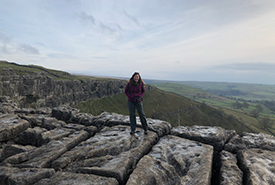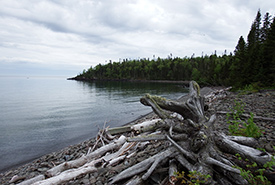Beech leaf disease: A new problem for Ontario trees

Early-stage leaf striping (Photo by John Pogacnik, Ohio Department of Natural Resources)
Beech bark disease began ravaging beech trees in Ontario in the late 1990s, after spreading west from Atlantic Canada. But recently, a new beech disease has emerged in the province. Beech leaf disease was first detected in North America in 2012 in...
Driving Miss Hazel

Hazel Bird Nature Reserve, ON (Photo by NCC)
Nature Conservancy of Canada (NCC) staff like to say that science drives our conservation work. This is true, but sometimes while following the science, we stumble into something unexpected and truly amazing. Let me explain. Back about 20 years...
Alvar explorations of a wandering biologist (part two)

Esme on the alvar in Malham Cove, U.K. (Photo by Esme Batten/NCC staff)
In part one, I explained what alvars are, where they occur and their importance. Now, I talk about my alvar explorations in the U.K. On Boxing Day in 2018, I set off early in the morning from Cornwall, in the southwest end of the U.K., to drive...
Where are they now? Intern Alumni Spotlight: Brett Norman

Brett Norman leading a hike at Backus Woods, ON (Photo by Len Grincevicius)
This blog marks the ninth Intern Alumni Spotlight — a series highlighting some of the individuals who have interned with the Nature Conservancy of Canada (NCC) in the past. Last month, Claire Elliott was featured as the Intern Alumni...
Where are they now? Intern Alumni Spotlight: Claire Elliott

Claire Elliott at a Conservation Volunteers event in Tabusintac, NB (Photo by Joanna Hudgins)
This blog marks the eighth Intern Alumni Spotlight — a series highlighting some of the individuals who have interned with the Nature Conservancy of Canada (NCC) in the past. Last month, Victoria Shore was featured as the Intern Alumni...
Wetlands in the Frontenac Arch

A wetland in the Frontenac Arch, ON (Photo by NCC)
Late last autumn, I was travelling with a friend through the Frontenac Arch. For me, this is a daily occurrence, but I sometimes forget that other people don’t see forests, lakes and wetlands on their morning commutes. It’s always a...
Measuring what matters: Biocapacity and ecological footprint

Participants of the joint Global Footprint Network and York University workshop (Photo courtesy of Martin J. Bunch, PhD)
The most-used measure of a country’s progress is its gross domestic product (GDP) — the value of the goods and services produced over a period of time, such as a year. A huge drawback of GDP, however, is that it does not fully reflect...
A world without wetlands

Brighton Wetland, Eastern Lake Ontario Coast (Photo by David Coulson)
I live next to a swamp. After 20 years of having this swamp as my neighbour, it’s kind of grown on me. I enjoy the spring flush of marsh marigolds, the annual reawakening of spring peepers, and I still smile when I see a colourful wood duck...
Dr. Crayfish, I presume?

Premek Hamr, PhD (a.k.a. Dr. Crayfish) (Photo courtesy of Premek Hamr, PhD)
At the Nature Conservancy of Canada's annual Ontario Region staff meeting last May, a few of us stepped outside to wander the shoreline of Lake Simcoe and admire the sunset. As we rooted around the rocky beach, I took a few photos of plants and...
The boreal forests of Wilson Island

Wilson Island, ON (Photo by NCC)
It was time to do a deep dive into the boreal forests of Wilson Island, near the north shore of Lake Superior. The Nature Conservancy of Canada (NCC) acquired these amazing 5,000 acres (2,023 hectares) in 2008, and it was time to conduct an...

